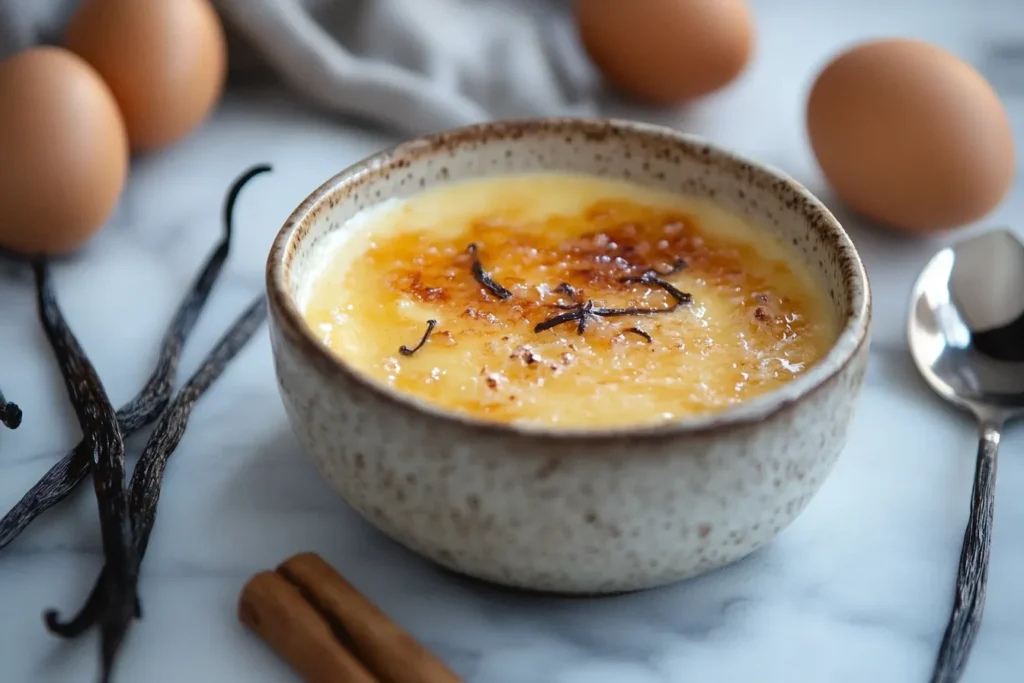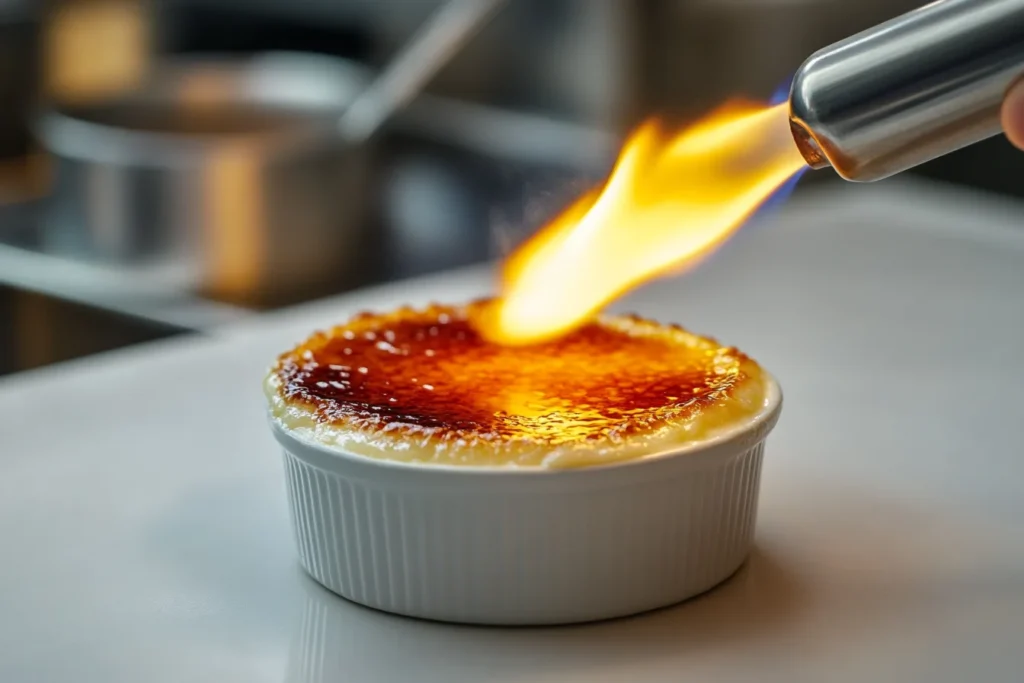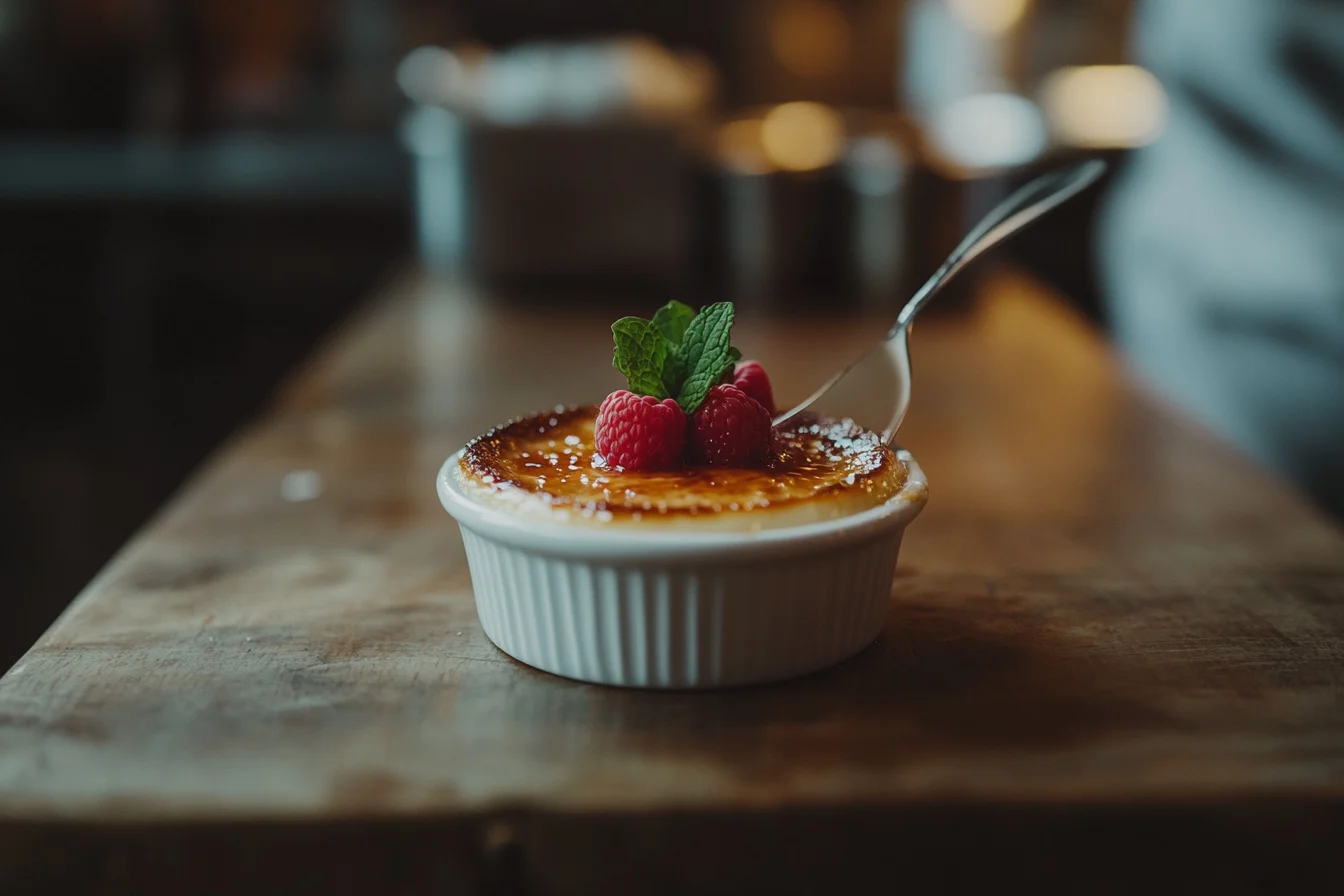Crème brûlée is more than just a dessert; it’s an experience—a delicate, creamy custard base topped with a perfectly caramelized sugar crust that cracks with an audible snap. But what is the secret to crème brûlée? Is it the ingredients, the technique, or perhaps a touch of magic? In this article, we’ll peel back the layers of this iconic French dessert to uncover its mysteries. From understanding the science behind its silky texture to mastering the caramelized topping, you’ll gain the know-how to create the perfect crème brûlée. Let’s dive into the sweet world of this culinary delight.
Understanding Crème Brûlée: A Brief History and Basics
The Origins of Crème Brûlée
The story of crème brûlée is as rich as its custard base. This classic dessert has its roots in French cuisine, yet its exact origins remain a topic of debate among culinary historians. Some believe it first appeared in 17th-century France, while others argue its roots trace back to Trinity College in Cambridge, England, where it was known as “burnt cream.” What remains undisputed is its status as a dessert synonymous with elegance and sophistication.
The term crème brûlée translates to “burnt cream,” a nod to its caramelized sugar topping. This distinctive layer isn’t just about aesthetics—it balances the rich custard with a satisfying crunch. Today, this dessert graces fine dining menus worldwide, celebrated for its simplicity and decadence.
Essential Ingredients and Their Roles
Crème brûlée’s perfection lies in its minimalism. The classic recipe calls for just five ingredients: heavy cream, sugar, egg yolks, vanilla, and a touch of salt. Each plays a critical role:
- Heavy cream provides the dessert’s luxurious richness and smooth texture.
- Sugar adds sweetness to the custard and forms the caramelized crust.
- Egg yolks bind the custard, lending structure and a velvety mouthfeel.
- Vanilla enhances flavor, with authentic vanilla beans adding an aromatic depth.
- Salt subtly elevates the flavors, bringing balance to the sweetness.
When combined with precision, these simple ingredients transform into a dessert masterpiece. Whether you’re a seasoned baker or a kitchen novice, understanding the basics sets the stage for mastering this iconic dish.
The Science Behind the Perfect Custard

The Role of Temperatures in Crème Brûlée
Temperature control is one of the secrets to crème brûlée. Why? Because the custard’s velvety texture hinges on precise heat management. If the temperature is too high, the eggs in the mixture can curdle, leaving you with an unappealing, scrambled texture. On the other hand, undercooking results in a runny custard that won’t set properly.
Baking the custard in a water bath, or bain-marie, is a popular method to maintain consistent temperatures. This technique ensures even cooking by surrounding the ramekins with gently heated water, preventing hot spots. Keep an oven thermometer handy to maintain the sweet spot of 325–350°F.
How Eggs and Cream Create the Signature Silky Texture
Ever wondered how crème brûlée gets its silky texture? It’s all about the interplay between the egg yolks and cream. Egg yolks serve as natural thickeners, while the cream provides richness and body. When these two ingredients are gently heated, their proteins coagulate, transforming the liquid mixture into a creamy custard.
To avoid overmixing or incorporating air, which can cause cracks or bubbles, whisk the yolks and sugar until just combined. Gently stirring the warm cream into the yolk mixture helps temper the eggs, gradually raising their temperature and preventing curdling. These steps ensure your custard is smooth and luscious.
Techniques for a Perfectly Caramelized Top

Selecting the Right Sugar for the Caramelized Layer
The caramelized sugar crust is a defining characteristic of crème brûlée. To achieve that signature crackling top, the type of sugar you use matters. Granulated sugar is the go-to choice due to its uniform crystals, which melt evenly under heat. Superfine sugar can also work well, as it caramelizes quickly, reducing the risk of burning.
Sprinkle an even layer of sugar over the custard, tapping the ramekins gently to distribute it evenly. Too much sugar creates a thick crust, while too little results in an uneven topping.
Using a Blowtorch vs. Broiler: Pros and Cons
The ultimate question: blowtorch or broiler? A blowtorch is the preferred method for professionals. It offers precise control, allowing you to caramelize the sugar evenly without warming the custard below. If you don’t have a torch, a broiler can do the job. However, be cautious—broilers apply intense, uneven heat that can overcook the dessert.
Hold the torch a few inches away from the sugar, moving it in circular motions to avoid scorching one area. Watch for the sugar to bubble and turn a golden-brown hue. With practice, you’ll master this crucial step and create the perfect caramelized crust every time.
Common Mistakes and How to Avoid Them
Overbaking and Undercooking
One of the most common issues with crème brûlée is getting the cooking time just right. Overbaking causes the custard to become stiff, losing its signature silky texture, while undercooking leaves it soupy and unappetizing. To avoid these pitfalls, keep a close eye on the ramekins while they bake.
The custard is done when the edges are set but the center jiggles slightly when gently shaken. This residual heat will continue to cook the custard as it cools. Using a water bath (bain-marie) is another excellent way to ensure even cooking and prevent the edges from overheating.
If you’re looking for more baking tips, check out this helpful article for guidance on achieving perfection in desserts.
Balancing Sweetness and Texture
Balance is everything when it comes to crème brûlée. Too much sugar can overwhelm the delicate flavor of the custard, while too little sugar results in a lackluster dessert. Stick to the classic ratio of cream to sugar and don’t skimp on the vanilla, as it’s essential for flavor depth.
Additionally, strain the custard mixture through a fine mesh sieve before pouring it into ramekins. This step removes any bits of curdled egg, ensuring a smooth and consistent texture. These small adjustments can make a significant difference in your final dish.
Variations on Classic Crème Brûlée
Innovative Flavor Infusions
While the classic vanilla crème brûlée is iconic, why not experiment with exciting flavors? Infusing the cream with herbs like lavender or spices like cinnamon can add an unexpected twist. You can also try using fruit purees like passion fruit or raspberry to create a tangy contrast to the rich custard.
For those who enjoy savory desserts, a touch of rosemary or even a hint of smoked sea salt can elevate the flavor profile. These unique combinations breathe new life into the traditional recipe.
Alternative Bases: Dairy-Free and Vegan Options
For those with dietary restrictions, crème brûlée can still be part of your dessert repertoire. Substitute coconut cream or almond milk for heavy cream to make a dairy-free version. You can replace egg yolks with agar-agar or cornstarch for a vegan option that still achieves the custard-like texture.
Want to explore more dessert ideas? Check out this guide for creative spins on classic recipes. With a few thoughtful substitutions and innovative ideas, crème brûlée becomes accessible to everyone while maintaining its signature appeal
Expert Secrets and Professional Tips
Pastry Chef Techniques for a Superior Crème Brûlée
So, what is the secret to crème brûlée? According to professional pastry chefs, it’s all about precision and attention to detail. Start by choosing high-quality ingredients. For example, using fresh, full-fat cream and real vanilla beans instead of extract elevates the flavor. The subtle aroma and depth of real vanilla create a more authentic and indulgent dessert.
Additionally, professionals recommend baking the custards in shallow ramekins rather than deep ones. Shallow dishes increase the surface area, allowing for a perfectly caramelized sugar crust and an even layer of custard. Another expert tip? Let the custard cool completely in the refrigerator before caramelizing the top. This prevents the custard from softening under the intense heat of the blowtorch.
Chefs also emphasize the importance of practice. Mastering crème brûlée requires experimenting with techniques and equipment, so don’t hesitate to test different methods until you perfect your craft.
Selecting Quality Ingredients: Why It Matters
The best crème brûlée starts with the best ingredients. Fresh, high-quality cream provides richness, while organic eggs give the custard its velvety texture. Opt for fine granulated sugar to ensure a smooth caramelization process. Even the water you use in the bain-marie should be filtered to avoid unwanted flavors.
Chefs suggest investing in a culinary blowtorch to achieve the iconic golden-brown crust. This tool offers better control than a broiler, reducing the risk of overheating the custard. With quality ingredients and the right tools, your crème brûlée will rival any restaurant’s.
FAQs on Crème Brûlée
Why Does My Crème Brûlée Crack?
A cracked custard often results from overbaking or incorporating too much air into the mixture. Avoid whisking the ingredients too vigorously, and bake at a low, consistent temperature. Using a water bath also minimizes sudden temperature changes, which can cause cracks.
Can I Make Crème Brûlée Ahead of Time?
Absolutely! Crème brûlée can be prepared up to two days in advance. Store the baked custards in the refrigerator, covered with plastic wrap. Caramelize the sugar topping just before serving to ensure it remains crisp and fresh.
How Do I Know If My Custard Is Done?
The perfect custard jiggles slightly in the center when gently shaken. If the entire custard moves, it needs more baking time. Conversely, if it’s completely firm, it may be overcooked.
What Is the Best Sugar for Crème Brûlée?
Granulated sugar is the best choice for the caramelized topping. Its even texture ensures a smooth and golden crust. Avoid using powdered sugar, as it can clump and burn unevenly.
By following these expert tips and answers to common questions, you’ll master the art of crème brûlée and delight your guests with this timeless dessert. Let me know if you’d like to explore any other sections further!
Pairing Crème Brûlée with the Perfect Complement
Best Beverage Pairings for Crème Brûlée
When savoring crème brûlée, pairing it with the right drink can elevate the experience. Sweet dessert wines, such as Sauternes or a late-harvest Riesling, complement the custard’s rich creaminess and balance its sweetness. For those who prefer a touch of acidity, a sparkling wine or Champagne provides a refreshing contrast.
If you’re a coffee lover, espresso is an excellent choice. Its bold flavor cuts through the dessert’s richness, creating a harmonious balance. Tea enthusiasts can opt for herbal teas like chamomile or mint to enhance the subtle flavors of the custard.
Serving Suggestions to Impress
Presentation matters just as much as taste. Serve crème brûlée in individual ramekins with a garnish of fresh fruit, such as raspberries or blackberries, to add a pop of color and flavor. A sprig of mint or a dusting of powdered sugar can also create a visually appealing dessert.
For a seasonal twist, consider pairing crème brûlée with a small side of spiced apple compote or a drizzle of caramel sauce. These simple yet elegant touches elevate the dining experience, ensuring your dessert is both memorable and delightful.
Crème Brûlée in Modern Cuisine
Innovative Takes on a Classic Dessert
Crème brûlée is no longer confined to traditional French menus. Modern chefs have reinvented this dessert, creating unique variations that push culinary boundaries. From matcha-infused custards to tropical flavors like mango and coconut, these creative adaptations offer exciting new ways to enjoy the classic.
Some restaurants even serve savory versions, such as goat cheese crème brûlée or one infused with truffle oil. These inventive twists showcase the dessert’s versatility, proving it’s far more than a simple custard.
What is the Secret to Crème Brûlée in Contemporary Kitchens?
The secret to crème brûlée in today’s kitchens lies in its adaptability. Chefs are incorporating cutting-edge techniques, such as sous vide cooking, to achieve perfect consistency. This method ensures precise temperature control, resulting in flawlessly creamy custards every time.
Additionally, the dessert’s compact size makes it ideal for personal servings in tasting menus or food trucks. Its timeless appeal, paired with modern innovations, ensures that crème brûlée remains a favorite for dessert enthusiasts everywhere.
These sections highlight crème brûlée’s enduring popularity and its evolution into a versatile masterpiece. Let me know if you’d like to add a concluding paragraph or refine any part further!

